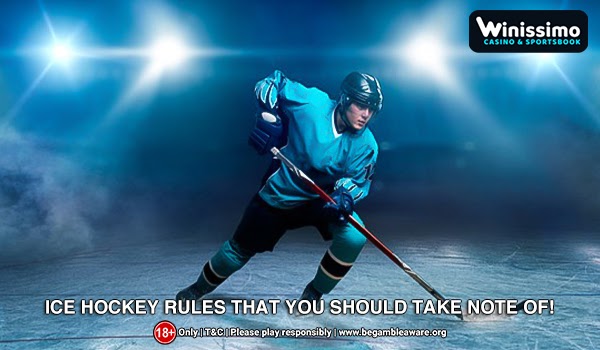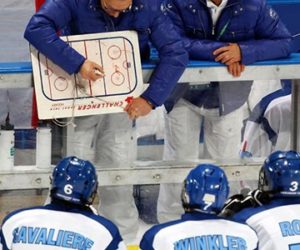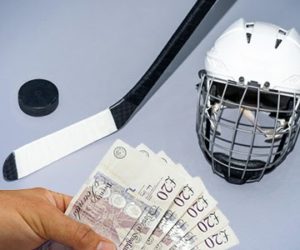The roots of ice hockey trace back to the 19th century in Canada, where, under snowy conditions, adaptations to the modern-day hockey game were played. Since then, with the largest competitors coming from North America, the sport has become one of the biggest in the world. The NHL (National Hockey League) is the world’s biggest league, turning over millions of dollars per year at present.

First let us go through some basic points about the game:
The game’s target
The game aims to drive a tiny puck onto the ground before smashing it into a net with a hockey stick. Each time the puck goes to the goal, the team is awarded one point. The puck will be moved on the ice around the players and the opposition must try to stop scoring of the other side. The champions are the team with the most targets after the game. The game will go into overtime if the match ends in a draw, where the first side to score will be declared champions.
Players & equipment
- On an ice rink measuring about 61m in length by 30m in width, the game is played. The rink is divided into 3 major parts. The neutral zone is the middle area which contains a centre circle where the games begin. There are attacking and defensive zones on each side of the neutral zone, which are decided by whatever team has the puck at the moment. Two end zone face-off circles and spots are present in both attacking and defending zones. There is an objective crease surrounding the target that is a half-circle. The region behind the target is the boards.
- In addition to ice skates and a variety of padding that could include a face mask, jersey, padded socks, shoulder pads, arm braces, and gloves, each player may have their hockey stick. Each tender would have the same purpose but on a much denser scale since they are much more often in the puck’s firing line.
- Each team will have 20 players at most. Just six of those 20 players are allowed to be on the ice at any moment. The others will be used as replacements, but as often as needed, they will come and go from the game. The six starters include a tender for a goal and five outfield players. Although a position will be given to each team, the players are free to move as they want across the ice. This removes the goalkeeper who must stay inside their half and not cross the red line of the middle.
- A ‘puck’ is hit by the players. The puck is a heavy item that weighs approximately 6 ounces and is made from thick rubber. The puck is struck by either the stick or the foot of a player, but no player other than the goalie can touch the puck at any time.
- Each game is played for three 20-minute periods. The game clock is stopped with any halts in the game and as soon as the time is up in each period, the game will end automatically.
- In the centre circle, the game begins with a face-off. This is where the referee drops the puck between two opposing teams, who then scrap for their side to take spot. In either of the attacking or defending face-off zones, a faceoff can also be used to restart play after a stoppage.
- Players can use physical force to separate their opponent from the puck. In the back or at shoulder height, body screening may be used but is not banned.
- For two minutes, players who are required to have committed a minor penalty will be ordered to leave the ice and their team plays for the time with 5 players. If the opposition side scores a goal in those two minutes, that player will automatically return to the ice.
- A minor penalty may involve tripping an opponent with their stick, holding a player without the puck with either their stick or paws, hooking with their stick or body checking.
- Large penalties can result in a player being excluded from the ice for as long as 5 minutes. These may involve combat, causing serious harm or continued minor breaches on opposition players.
- Ice hockey, commonly viewed as the ‘fastest game on earth,’ is brutal. In many ways, with a special combination of speed, physicality and skill, as well as the occasional scrap, it is the ideal sport for neutrals!
- Ice hockey is an established sport around the world nowadays. Obviously, for any ambitious young player, the NHL is the ultimate target, but ice hockey betting tips are readily available throughout the globe.
- Ice hockey betting is really easy and below are some of the top ice hockey betting advice guides that can be used by the punters. The competitive essence of ice hockey is matched by none and it rates as one of the sport’s most thrilling spectacles.
- First and foremost, to win a competition, you should gamble outright on a band.
- Of the best foreign teams vying for dominance, the Ice Hockey World Championship is the largest global occurrence.
- Be careful of ice hockey betting phrases when betting on a side to win a single match. That means your choice must win the match by the end of the third quarter if the market is to win in regulation.
- Most bookmakers, however, encourage punters to back a team to win, including overtime, which ensures additional protection for punters when betting on ice hockey.
- As is the case in many American games, spread betting odds for ice hockey betting can be found by punters. Essentially, if you expect a secure win, this offers you a chance to raise the betting on a favourite.
- The final ice hockey betting choice that is commonly available is for total goals. You should back the ‘over’ total goals line if you anticipate a high scoring game, which is especially helpful if you don’t have a deep desire for either side to win the game.
- The best free ice hockey betting tip we can give is to do a lot of homework, whether you are trying to put a bet on an upcoming ice hockey match or looking for a deserving outright winner.
- Just gamble while you can afford your free budget betting tips for ice hockey and stick to them.
- Picking a reputable bookmaker is one of the critical tips for ice hockey betting. Within the online bookmakers, this sport has outstanding coverage, which is a huge bonus. It is very easy and straightforward to put your wagers online with platforms like Winissimo. You can do that from the convenience of your own house and not waste your time travelling.
- The full selection of additional facilities is another great advantage of online sports betting. There are now several web sites, so everyone attempts to provide additional resources to suit your purposes.

Scoring
A player must hit the puck over the goal line to score a goal. Every part of their body or their stick can be used to do so, but their hand cannot be used. To be called a goal, the entirety of the puck must cross the line. The goal line has a sensor running over it in competitive sports like the NHL, which signals that the puck has passed the line entirely. The judgement of the umpires is taken into account in the amateur leagues.
The game-winning
One side has to score more goals than their opponents to win a game. The game goes into overtime if the match is a draw and an extra quarter is played out before one of the teams’ scores. The winners are going to be the first team to score.
Ice hockey rules

Face-offs in ice hockey
Face-offs are used after a stoppage to resume game times and to resume play. In a face-off, two opposing players stand facing each other at about one stick’s blade apart and the official drops the puck between them. So, the two players try to gain hold of the puck.
Match officials
The game is regulated by the referee (who wears a red armband) and takes the final decision on every matter. Linesmen, who are concerned with offside, and goal judges, who look to see whether the puck has hit the goal line or not, support the referee.
Physical contact
At the professional stage, because of the constant body checks and other physical action on the ice, ice hockey has gained a reputation for being an aggressive sport, but it is not a free-for-all where players can get away with anything they want. The rules say that touch is good from the side and front, but intentional checking from behind (slowing or hindering an opponent) would typically result in a penalty.
Tripping opponents and causing players to strike the walls of the rink aggressively is forbidden, as is elbowing, charging, high use of the stick, and using the stick shaft to search an opponent. The pace of the game, of course, ensures that all of these incidents happen, and then it is up to the referee to determine if an offence has been committed and if it is appropriate to administer a penalty.
Penalties
Penalties vary from minor penalties, usually resulting in a player being sent off for 2 minutes, to severe penalties, and are provided for more significant physical activity. A substantial punishment will lead to the responsible player being sent off indefinitely.
The growing popularity of Ice hockey leading to increased betting on it

Ice Hockey betting advice

You would almost definitely be familiar with most of the ice hockey betting markets if you are an avid sports betting strategy and top tips follower. Some of them are particular to the sport, but most are more common.
Final thoughts
If you know a few simple rules and regulations, the world’s best and most thrilling game is easy to follow. Once you are through with this guide on the rules and betting tips, you can try your luck at ice-hockey betting. Good luck!
Summary
Name: Ice Hockey Rules that You Should Take Note Of!
Posted On: 05/12/2020
Author: Jessica Wilson
